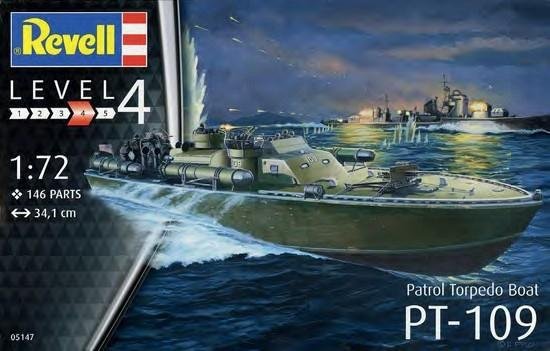CRAFT FIT FOR A PRESIDENT

PT-109
By: Revell
Item no: 05447 Price: £22.99
Web: www.revell.de/en
Modellers were excited by Revell’s announcement of a newly tooled PT-109 at Nuremburg earlier this year, and this kit is sure to please many, given its historical importance as a vessel commanded by future US President John F Kennedy. It comprises 14 styrene runners (including three small clear frames) and separate hull halves and deck, and there’s a detailed interior and wheelhouse, the latter benefiting from decals for the instrument panels. External features are reproduced faithfully, notably the torpedo tubes and depth charges, while the 20mm Oerlikon and twin .50 cal mounts are excellent. There’s even an M3 37mm anti-tank gun, as fitted to the vessel in place of a life raft, the day before its fateful mission on August 1, 1943…but modellers will need to supply their own thread to lash the gun in position. Revell offers two schemes, covering the periods before (August 1942 to February 1943) and during (April – August 1943) Kennedy’s command.
JESSEL’S L-CLASS VESSEL

HMS Legion 1941
By: Flyhawk Model
Item no: FH 1103S Price: £36
Web: www.flyhawkmodel.com Flyhawk surprised many with this release, the first styrene kit of an L-class destroyer, and its deluxe edition marries the already impressive styrene components with two extra photo-etched brass frets, turned brass gun barrels and lengths of brass rod for new tripod masts. There are ‘merely’ ten runners, plus separate upper/lower hulls, deck halves and forward/ aft superstructure sections, all oozing with detail and refinement…all this for is model that’s approximately 6in (15cm) long! Features such as the main armament turrets (with open rear sections), and the multiple depthcharge throwers are captured faithfully; the former would put larger-scale offerings to shame. The single scheme depicts HMS Legion (which served for just two years under Captain Richard Jessel) in 1941, wearing standard early war Dark Grey 507A/Light Grey 507C colours. Flyhawk kits are available in the UK from Starling Models (www.starlingmodels.co.uk)
GORGEOUS RIVER GUNBOAT

Gilyak
By: Combrig
Item no: 3591
Price: US $82.10
Web: www.combrig-models.com Nineteenth-century Imperial Russian ships aren’t represented too well in kit form, especially those designed for river patrol and border enforcement, making Combrig’s resin and photoetched brass Gilyak doubly welcome…especially as it offers a choice of waterline or fullhull format. Unsurprisingly, the single-piece upper hull is the highlight, with its integrally cast decking, watertight doors, bollards, bitts and open chocks, but Combrig has also sanded/ polished the casting surfaces for the upper and lower hull, enabling an instant near-perfect seam when mated. There are more than 110 equally fine resin components, with PE railings, ladders, ship’s wheels, lifeboat inners, and even filigree ornamental ironwork for the bows, which will demand careful brush work. No colour scheme information is provided, but all peacetime Imperial Russian Navy vessels had a white upper hull and superstructure, with varnished wooden decks, tan funnels (with black tops) and either green or red lower hullsà references will be vital.
BLIGHTY’S SILENT HUNTER

HMS Astute
By: Trumpeter
Item no: 05909
Price: £49.99 Web: www.pocketbond.co.uk Submarine kits aren’t overly complex, and despite its impressive size, Trumpeter’s HMS Astute comprises just two styrene runners (including one for the stand), separate upper/lower hulls and a small photo-etched brass fret. It’s a mixed bag in terms of accuracy, as while the general shape appears faithful (although the propulsor is hidden on the real thing), it lacks finer nuances. The hull configuration is for a submerged vessel, yet fittings near the bow seem to be for a surfaced version (but there are no jacks for the ensigns); furthermore, no option is supplied for an open conning tower station…disappointing given its full-hull nature. Modellers will need to scratch-build plating around the bow planes, correct the sonar housing, and add relief on the conning tower, before addressing the latter’s misshapen ‘collar’. While the decals for the single scheme are comprehensive, they appear over-bright, but the waterline marking for the vertical fin leading edge is omitted.

